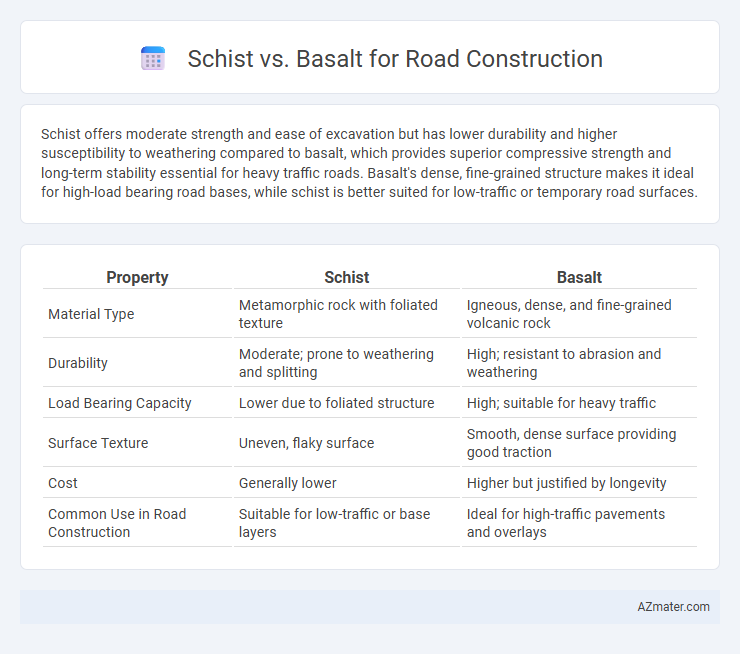Schist offers moderate strength and ease of excavation but has lower durability and higher susceptibility to weathering compared to basalt, which provides superior compressive strength and long-term stability essential for heavy traffic roads. Basalt's dense, fine-grained structure makes it ideal for high-load bearing road bases, while schist is better suited for low-traffic or temporary road surfaces.
Table of Comparison
| Property | Schist | Basalt |
|---|---|---|
| Material Type | Metamorphic rock with foliated texture | Igneous, dense, and fine-grained volcanic rock |
| Durability | Moderate; prone to weathering and splitting | High; resistant to abrasion and weathering |
| Load Bearing Capacity | Lower due to foliated structure | High; suitable for heavy traffic |
| Surface Texture | Uneven, flaky surface | Smooth, dense surface providing good traction |
| Cost | Generally lower | Higher but justified by longevity |
| Common Use in Road Construction | Suitable for low-traffic or base layers | Ideal for high-traffic pavements and overlays |
Introduction to Schist and Basalt in Road Construction
Schist and basalt are commonly used materials in road construction, each offering unique properties suited to specific engineering needs. Schist, a metamorphic rock characterized by its foliated texture and ease of splitting, is valuable for subgrade layers and drainage applications due to its porosity and ability to withstand moderate loads. Basalt, an igneous volcanic rock known for its high density, hardness, and durability, is widely preferred for base layers and surface pavement, providing excellent load-bearing capacity and resistance to weathering.
Geological Formation and Composition
Schist, a metamorphic rock characterized by its foliated texture, forms under intense heat and pressure from shale, containing abundant mica and quartz, which provide moderate strength but prone to weathering. Basalt, an igneous volcanic rock, cools rapidly from lava flows, composed mainly of plagioclase and pyroxene minerals, offering high durability and dense structure ideal for heavy load-bearing in road construction. The geological formation and mineral composition differences influence their performance: basalt's hardness and low porosity make it superior for asphalt aggregate, while schist's foliation may reduce its structural integrity over time.
Physical and Mechanical Properties
Schist exhibits moderate compressive strength and good durability with high foliation, which can lead to anisotropic behavior affecting load distribution in road construction. Basalt offers superior compressive strength, high hardness, and excellent abrasion resistance, making it ideal for high-traffic road surfaces requiring long-term durability. The dense, fine-grained structure of basalt provides better mechanical stability and resistance to weathering compared to the foliated, often weaker schist.
Durability and Weathering Resistance
Basalt exhibits superior durability and weathering resistance compared to schist, making it a preferred choice for road construction in harsh climates. Its dense, fine-grained structure withstands abrasion, freeze-thaw cycles, and chemical attack more effectively than the foliated and weaker layers of schist. Schist's susceptibility to splitting and erosion reduces its long-term performance and increases maintenance costs on roadways.
Load-Bearing Capacity and Strength
Basalt exhibits higher load-bearing capacity and compressive strength compared to schist, making it more suitable for heavy-duty road construction. Schist's foliated structure results in lower strength and durability under stress, which can lead to deformation and surface failure over time. Consequently, basalt's dense, fine-grained composition ensures superior stability and longevity for road bases and pavements.
Workability and Processing
Schist exhibits moderate workability in road construction due to its foliated texture, which allows easier splitting but requires careful handling to avoid excessive fragmentation during processing. Basalt offers superior workability with high compressive strength and durability, making it ideal for producing high-quality aggregates through crushing and screening processes. Processing schist involves more labor-intensive sorting to remove weak planes, whereas basalt's dense, fine-grained structure enables efficient crushing and consistent particle size distribution for road base applications.
Cost Considerations and Availability
Schist generally incurs higher costs for road construction due to its variable quality and the need for extensive processing to achieve suitable durability, whereas basalt offers a more cost-effective option because of its widespread availability and superior hardness, leading to lower maintenance expenses. Basalt's abundance in many regions reduces transportation costs compared to schist, which is less commonly found and may require sourcing from distant quarries. Choosing basalt can enhance the economic efficiency of road projects through longer lifespan and reduced repair frequency, making it preferred in cost-sensitive infrastructure development.
Environmental Impact and Sustainability
Schist and basalt differ significantly in environmental impact and sustainability when used in road construction. Basalt, a dense volcanic rock, offers superior durability and long-term stability, reducing the need for frequent repairs and resource extraction, which lowers the overall environmental footprint. Schist, being a metamorphic rock with a foliated structure, is less durable, potentially increasing maintenance frequency and associated environmental disturbance, making basalt the more sustainable choice for road base materials.
Case Studies: Real-World Applications
Case studies reveal that basalt outperforms schist in road construction due to its higher compressive strength and durability under heavy traffic loads, as demonstrated in projects across volcanic regions like Oregon and Hawaii. Schist, while more readily available and easier to quarry, often requires stabilization treatments to enhance its mechanical properties, shown in roadways within the Indian Himalayas. The comparative analysis underscores basalt's superior resistance to weathering and abrasion, making it the preferred aggregate in long-term infrastructure development.
Conclusion: Best Choice for Road Construction
Basalt outperforms schist in road construction due to its higher compressive strength, durability, and resistance to weathering, making it more suitable for heavy traffic and long-lasting pavements. While schist offers ease of quarrying and shaping, its foliated structure reduces overall stability and increases the risk of fracturing under load. Therefore, basalt is the preferred aggregate for road construction projects requiring maximum structural integrity and longevity.

Infographic: Schist vs Basalt for Road Construction
 azmater.com
azmater.com